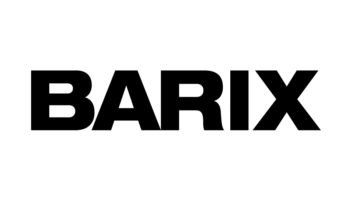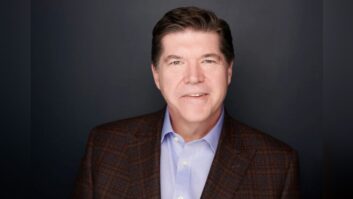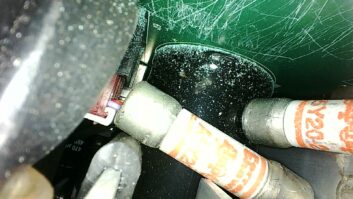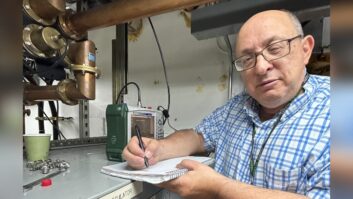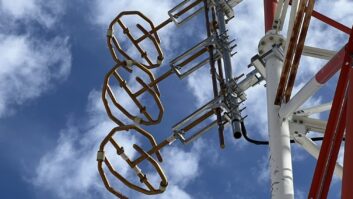(click thumbnail)Sunset warms the towers on Mt. Wilson.Manufacturer Says That, When Used Correctly, Device Is Good Business and Sound Technology
SAN JOSE, Calif. An audio time-reduction device that uses a delay to create additional advertising time is meeting with disapproval from the advertising community, as its use by radio stations across the United States becomes more widely known.
On-air clutter?
The American Association for Advertising Agencies has voiced its displeasure with the Cash device, manufactured by Prime Image in San Jose, Calif. The AAAA cites concerns over commercial length and on-air clutter
Prime Image says it has sold approximately 60 of the Cash units in the United States since introducing it in 1999. Cash offers radio stations a chance to maximize profits by manufacturing additional time in their broadcast day. According to Prime Image promotional literature, the machine works using “intelligent microediting.” Data compression is not used in the process; rather, the device looks for material that is less detectable to the human ear and removes it.
Cash uses an audio delay memory to create up to six minutes of additional commercial insertion time per hour during live programming.
Audio chain
The unit is inserted into the station’s audio chain ahead of the processors. When started, it begins storing program material in the audio delay memory. Output will not begin until after the programming preset delay time has elapsed. Additional commercial time is created during this delay and the additional spot material is inserted into the transmitted signal.
The Cash unit can be programmed to perform various insertion times. For instance, stations could program a 30-second insertion over a 10-minute segment or 60 seconds over a 40-minute segment.
Although some radio stations like Cash for its ability to increase commercial inventory, many are reluctant to say they use it for a variety of reasons, including the perception that Cash might affect audio quality.
The Silicon Valley company made headlines last fall when a Pittsburgh television station used its delay gadget, called the Time Machine, to insert an additional 30-second commercial during a Pittsburgh Steelers football game.
A media critic noticed the time delay between the TV broadcast and radio broadcast and reported it. Some advertisers have since criticized the television industry for its use of the Time Machine.
Prime Image officials say more than 120 Time Machine units are used at U.S. television stations.
Ad executives express two immediate concerns about the Cash device for radio. They say Cash devalues commercial material by “shoehorning in” additional units. The other concern is commercial length.
“We expect our clients to receive what they pay for. The job of the agency is to look out for the best interest of the client and to make sure they get the full amount of time delivered,” said O. Burtch Drake, president of the AAAA.
Drake said the last thing radio needs is more clutter by creating additional commercial units.
“You can shoehorn more commercials in, but it hurts both the station and the advertiser. That’s why we are taking a very strong stand against this kind of technology when used to compress material in any way.”
Bill Hendershot, president of Prime Image, said Cash cuts tiny indistinguishable audio segments resulting in no pitch change or other anomalies.
“Mathematically, the way this thing works, it does not change the pitch. Cash throws away small audio packets of 5 or 6 milliseconds over the course of an hour to gain the extra time needed for a 30- or a 60-second commercial. You cannot detect that anything has happened,” Hendershot said.
The unit has a buffer in which it temporarily stores the live audio signal. Once the programmed delay time has passed and after the added material is inserted, the unit begins to turn out audio.
(click thumbnail)
Delay slowly reduced
Over the course of the program’s length, the delay slowly is reduced until, at the end of the program, there is no longer a delay and the program finishes on time.
Prime Image recommends a reduction rate of no more than an 8 to 10 percent per hour. That translates into a gain of five to six minutes of commercial insertion time, Hendershot said.
Cash has a list price of $12,000.
“The average radio station could pay for the product in three to four months. And that’s not by overdoing it either. Using it three or four times a day is probably realistic.
“I don’t consider that being clutter. We realize if our customers overuse it they could start driving advertisers away.”
Hendershot said a hold function in Cash can be used when commercials are aired, either manually or automatically, therefore not shortening commercial material. He said, “It is up to the individual stations to use the function.”
Major- and medium-market radio stations with various formats – from news/talk to CHR – are using Cash, Hendershot said, but he declined to identify any users.
Hendershot said many of the Cash units are being used along with Prophet Systems Innovations studio control systems.
Several industry observers, who wished to remain anonymous, said demand for Cash likely has decreased as the result of lighter commercial loads and sagging advertising dollars in the recession. They said the introduction of Cash during the economic feast of several years ago came at a time of heavy demand upon commercial inventory, forcing radio stations to look for ways to maximize profits.
“Sales for Cash have remained steady since Sept. 11 last year. Television demand has slowed greater than radio,” Hendershot said.
The fact that stations have used Cash has caused controversy in the past.
Rush Limbaugh voiced displeasure with Cash two years ago when several radio stations used the technology to squeeze additional ad time out of his four-hour show. In particular, Limbaugh pointed out the former WWDB(FM) in Philadelphia as the chief offender.
“I think (Cash) is the potential doom for the radio industry,” Limbaugh said at the time. Limbaugh claimed the device shortened the dramatic pauses he used for effect. Hendershot said Cash did not interfere with Limbaugh’s “artistic pauses” as the radio host had proclaimed.
The Philadelphia station, owned by Beasely Broadcast Group, has since changed call letters to WPTP and adopted an ’80s oldies format. It no longer carries Limbaugh’s show.
Chris Sarris, former chief engineer at WWDB, said the station experimented with Cash to gain five minutes of commercial time per hour during Limbaugh’s show, but settled on a maximum of four.
Complaints
“The difference was definitely noticeable at that rate. However, we used Cash only after we had learned the station was losing Rush’s show. Management was trying to maximize revenue in a short time. That’s why we used it,” Sarris said. He said the station regularly received several complaint calls a day.
Sarris, chief engineer at WBEB(FM) in Philadelphia, said Cash was “undetectable” when set for a gain of two minutes or less per hour.
“I think it’s a good tool for use in a smaller market where a couple of extra commercials per hour would be the difference if a station could afford a national show or not,” Sarris said.
Don Melnyk, chief at WPTP, said the station no longer uses Cash.
Another station involved in the Limbaugh controversy was WABC(AM) in New York, owned by ABC Radio Inc., which suspended the use of its unit temporarily. Program Director Phil Boyce said the station still has the box but seldom uses it.
“We only use it at times when we are in a sold-out situation. That has not happened very often with the economy where it is now,” Boyce said. “We never use it to generate any more than an extra minute per hour anyway.”
Boyce said the Rush complaints arose when the Philadelphia radio station tried to “bastardize” the Cash machine and squeeze more time out of the show than was recommended, which compromised the on-air sound.
“The technology can be a big benefit to a radio station if used within reason. That means not being so greedy that you overuse the device,” Boyce said.
Six major broadcast groups contacted for this story said they do not use Cash at any of their radio stations.
They include Hispanic Broadcasting Corp., Emmis Communications, Citadel Communications, Greater Media, Infinity Broadcasting and Cumulus Broadcasting.
A spokesman for Clear Channel Communications, could not confirm if any of that group’s stations use Cash and declined further comment.
David Stewart, director of engineering for Hispanic Broadcasting Corp., said, “We looked at Cash when it first became available. It was tempting to some managers, but we passed on it. We have a firm policy within the group that limits the number of spots stations are allowed to play per hour.”
Hispanic Broadcasting programmers and consultants were particularly concerned about driving listeners away by “jamming in too many ads” with additional commercial time, Stewart said.
Emmis Communications spokeswoman Kate Healy said the broadcaster feels there are more effective tools than Cash to increase revenue.
“We believe getting great ratings and selling our inventory at an effective price is better than digitally wedging another unit into an hour,” Healy said.





